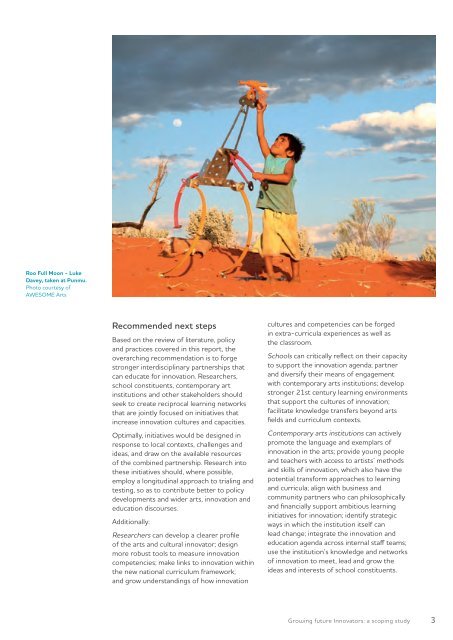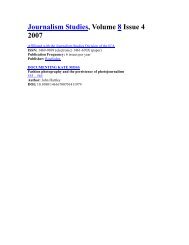GrowinG Future innovators - ARC Centre of Excellence for Creative ...
GrowinG Future innovators - ARC Centre of Excellence for Creative ...
GrowinG Future innovators - ARC Centre of Excellence for Creative ...
Create successful ePaper yourself
Turn your PDF publications into a flip-book with our unique Google optimized e-Paper software.
Roo Full Moon - Luke<br />
Davey, taken at Punmu.<br />
Photo courtesy <strong>of</strong><br />
AWESOME Arts<br />
Recommended next steps<br />
Based on the review <strong>of</strong> literature, policy<br />
and practices covered in this report, the<br />
overarching recommendation is to <strong>for</strong>ge<br />
stronger interdisciplinary partnerships that<br />
can educate <strong>for</strong> innovation. Researchers,<br />
school constituents, contemporary art<br />
institutions and other stakeholders should<br />
seek to create reciprocal learning networks<br />
that are jointly focused on initiatives that<br />
increase innovation cultures and capacities.<br />
Optimally, initiatives would be designed in<br />
response to local contexts, challenges and<br />
ideas, and draw on the available resources<br />
<strong>of</strong> the combined partnership. Research into<br />
these initiatives should, where possible,<br />
employ a longitudinal approach to trialing and<br />
testing, so as to contribute better to policy<br />
developments and wider arts, innovation and<br />
education discourses.<br />
Additionally:<br />
Researchers can develop a clearer pr<strong>of</strong>ile<br />
<strong>of</strong> the arts and cultural innovator; design<br />
more robust tools to measure innovation<br />
competencies; make links to innovation within<br />
the new national curriculum framework;<br />
and grow understandings <strong>of</strong> how innovation<br />
cultures and competencies can be <strong>for</strong>ged<br />
in extra-curricula experiences as well as<br />
the classroom.<br />
Schools can critically reflect on their capacity<br />
to support the innovation agenda; partner<br />
and diversify their means <strong>of</strong> engagement<br />
with contemporary arts institutions; develop<br />
stronger 21st century learning environments<br />
that support the cultures <strong>of</strong> innovation;<br />
facilitate knowledge transfers beyond arts<br />
fields and curriculum contexts.<br />
Contemporary arts institutions can actively<br />
promote the language and exemplars <strong>of</strong><br />
innovation in the arts; provide young people<br />
and teachers with access to artists’ methods<br />
and skills <strong>of</strong> innovation, which also have the<br />
potential trans<strong>for</strong>m approaches to learning<br />
and curricula; align with business and<br />
community partners who can philosophically<br />
and financially support ambitious learning<br />
initiatives <strong>for</strong> innovation; identify strategic<br />
ways in which the institution itself can<br />
lead change; integrate the innovation and<br />
education agenda across internal staff teams;<br />
use the institution’s knowledge and networks<br />
<strong>of</strong> innovation to meet, lead and grow the<br />
ideas and interests <strong>of</strong> school constituents.<br />
Growing future Innovators: a scoping study 3




![Plebiscite (Riegert chapter) revised FINAL [Feb 14].pdf](https://img.yumpu.com/8710373/1/190x245/plebiscite-riegert-chapter-revised-final-feb-14pdf.jpg?quality=85)